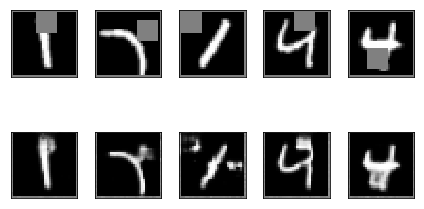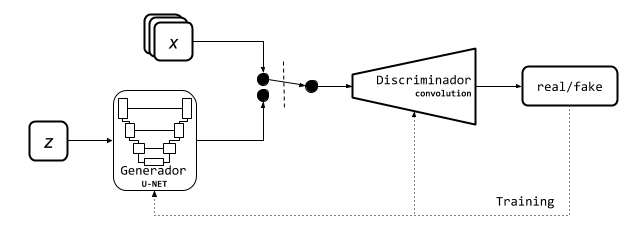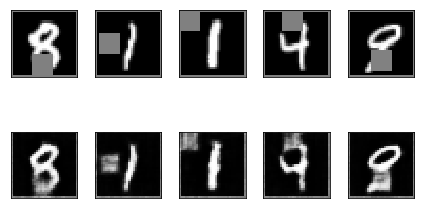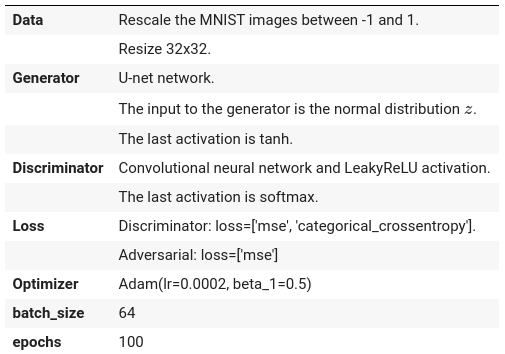GANs — Context-Conditional GANs with MNIST (Part 5)
Brief theoretical introduction to Context-Conditional Generative Adversarial Nets or CCGANs and practical implementation using Python and Keras/TensorFlow in Jupyter Notebook.

In this article, you will find:
- Research paper,
- Definition, network design, and cost function, and
- Training CCGANs with MNIST dataset using Python and Keras/TensorFlow in Jupyter Notebook.
Research Paper
Denton, E.L., Gross, S., & Fergus, R. (2016). Semi-Supervised Learning with Context-Conditional Generative Adversarial Networks. ArXiv, abs/1611.06430.
Context-Conditional Generative Adversarial Nets — CCGANs
Context-Conditional Generative Adversarial Networks (CC-GANs) are conditional GANs where
- The Generator 𝐺 is trained to fill in a missing image patch and
- The Generator 𝐺 and Discriminator 𝐷 are conditioned on the surrounding pixels.
CC-GANs address a different task:
- Determining if a part of an image is real or fake given the surrounding context.
The Generator 𝐺 receives as input an image with a randomly masked out patch. The Generator 𝐺 outputs an entire image. We fill in the missing patch from the generated output and then pass the completed image into 𝐷.
Read more about GANs:
Network design

x is the real data and z is the latent space.
Cost function

Training CCGANs
- Data: MNIST dataset
(X_train, y_train), (X_test, y_test) = mnist.load_data()2. Model:
- Generator
# Generator network
generator = Sequential()# Downsampling
d1 = Conv2D(gf, kernel_size=k, strides=s, padding='same')(img_g)
d1 = LeakyReLU(alpha=0.2)(d1)d2 ...
d3 ...
d4 ...
d4 = BatchNormalization(momentum=0.8)(d4)
# Upsampling
u1 = UpSampling2D(size=2)(d4)
u1 = Conv2D(gf*4, kernel_size=k, strides=1, padding='same', activation='relu')(u1)
u1 = BatchNormalization(momentum=0.8)(u1)u2 ...
u3 ...
u4 ...
u4 = Conv2D(1, kernel_size=4, strides=1, padding='same', activation='tanh')(u4)
generator = Model(img_g, u4)
- Discriminator
# Discriminator network
discriminator = Sequential()discriminator.add(Conv2D(64, kernel_size=4, strides=2, padding='same', input_shape=img_shape))
discriminator.add(LeakyReLU(alpha=0.8))# Con2D 128, Conv2D 256
...
img_d = Input(shape=img_shape)
features = discriminator(img_d)
validity = Conv2D(1, kernel_size=k, strides=1, padding='same')(features)
label = Flatten()(features)
label = Dense(num_classes+1, activation="softmax")(label)
discriminator = Model(img_d, [validity, label])
3. Compile
optimizer = Adam(lr=0.0002, beta_1=0.5)
discriminator.compile(optimizer=optimizer, loss=['mse', 'categorical_crossentropy'], loss_weights=[0.5, 0.5], metrics=['accuracy'])# The generator takes noise as input and generates imgs
masked_img = Input(shape=(img_shape))
gen_img = generator(masked_img)discriminator.trainable = Falsevalidity, _ = discriminator(gen_img)
d_g = Model(masked_img, validity)
d_g.compile(optimizer=optimizer, loss='mse', metrics=['accuracy'])
4. Fit
# Train Discriminator weights
discriminator.trainable = True
# Real samples
img_real = X_train[i*batch_size:(i+1)*batch_size]
real_labels = y_train[i*batch_size:(i+1)*batch_size]
d_loss_real = discriminator.train_on_batch(x=img_real, y=[real, real_labels])
# Fake Samples
masked_imgs = mask_randomly(img_real)
gen_imgs = generator.predict(masked_imgs)
d_loss_fake = discriminator.train_on_batch(x=gen_imgs, y=[fake, fake_labels])
# Discriminator loss
d_loss_batch = 0.5 * (d_loss_real[0] + d_loss_fake[0])
# Train Generator weights
discriminator.trainable = Falsed_g_loss_batch = d_g.train_on_batch(x=img_real, y=real)
5. Evaluate
# plotting the metrics
plt.plot(d_loss)
plt.plot(d_g_loss)
plt.show()CCGANs — MNIST results


Train summary

Github repository
Look the complete training CCGAN with MNIST dataset, using Python and Keras/TensorFlow in Jupyter Notebook.
For those looking for all the articles in our GANs series. Here is the link.
